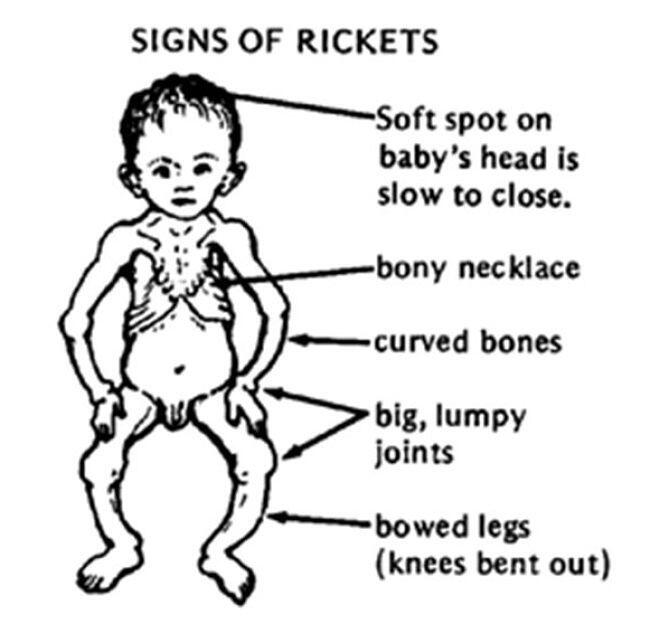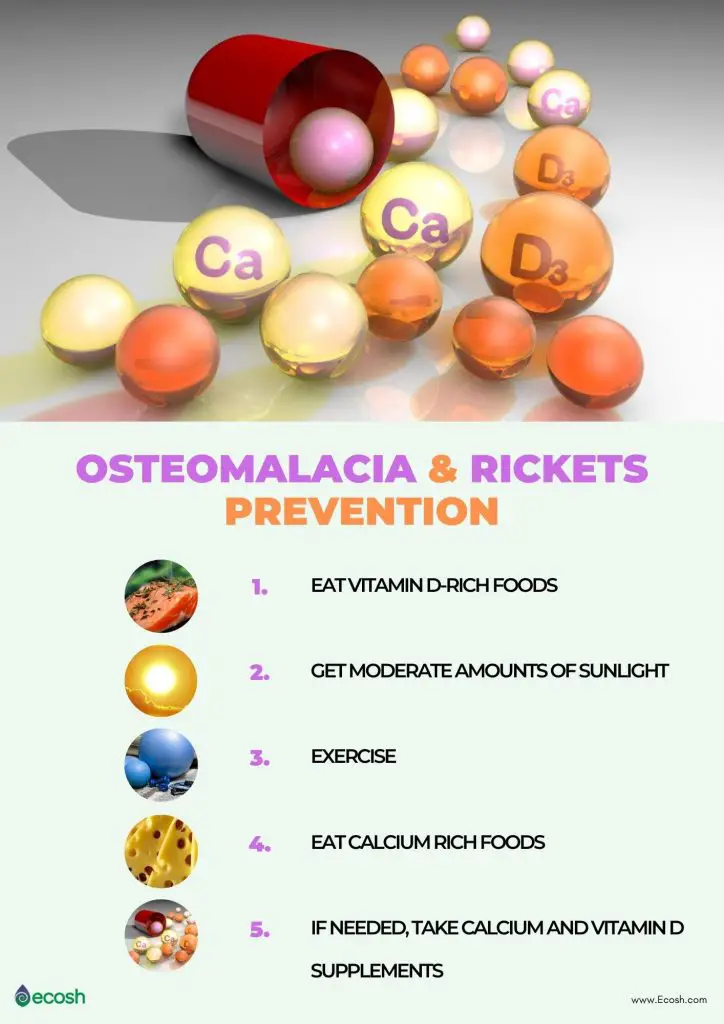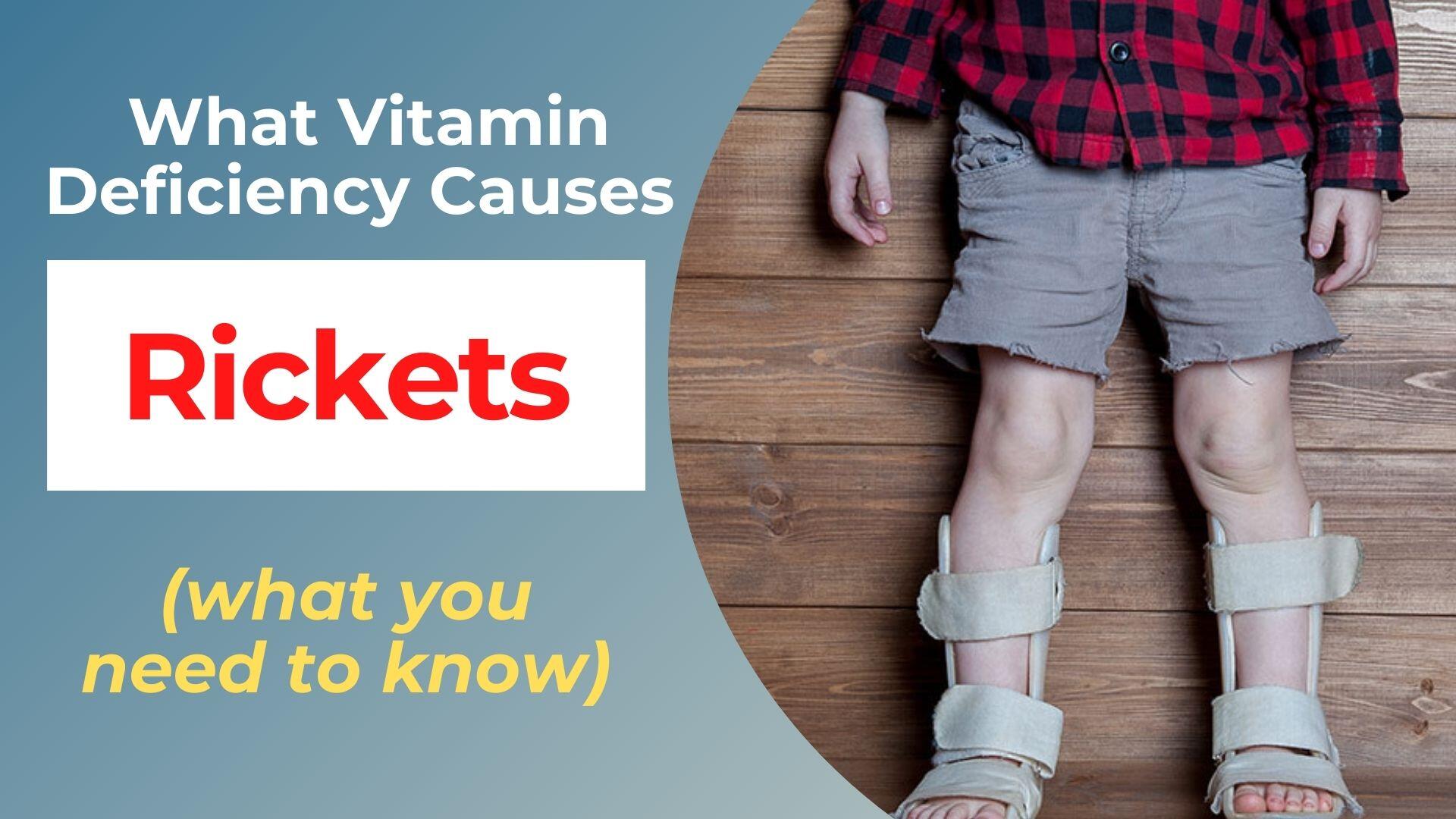Did you know that a vitamin deficiency can cause rickets?
Rickets is a childhood disease, and it’s the most common bone disorder. It’s caused by a lack of vitamin D or calcium.
The lack of these two nutrients causes bones to be soft, brittle, and easily broken.
In this blog post we’ll go over what vitamin deficiencies cause the signs of rickets so that parents can spot them in their children!
Signs

One of the first signs kids might have rickets is a delay in what’s known as “sitting.”
Babies normally develop what’s called the tripod position by sitting on their bottom with their legs bent, but without vitamin D or calcium they won’t be able to do this.
They may instead cross both feet over one side while lying down and not sit up until around six months old.
Another sign that could indicate your child has rickets is if they don’t crawl when expected (normally happen between five and eight months). This happens because babies need vitamin D for bone growth, so if it’s lacking then crawling can be difficult.
Rickets also affects growth plates which are areas where bones grow.
This can cause what’s known as bow legs, where one leg is shorter than the other. This happens when the bone in that area isn’t growing at a normal rate which causes it to be weaker and more likely to break.
It might also affect elbows making them turn inward instead of pointing out like they should normally do for kids this age (usually by nine months). When rickets affects growth plates in arms it makes what are called “knock-knees” or what looks like bowed legs from behind.
Overall, the signs of rickets:
- Delayed development
- Motor skills that are delayed
- Back, pelvic, and calf pain are common
- Weakness in muscles
- Oddly formed knees or elbows
How Rickets is Diagnosed
Doctors can diagnose rickets by looking at what’s called an x-ray.
They’ll be able to see what are called “fragile” bones which means their growth plates aren’t strong enough and need vitamin D or calcium in order to grow normally.
When it comes time for a diagnosis, doctors will typically look at the signs your child is having and then run blood tests on them to check what levels of calcium, phosphorus, and vitamin D they have in their body. If any one these numbers fall below what’s normal for kids this age (usually around ten years old), then a doctor may suspect that you kid has rickets.
If the blood tests come back with low levels of certain vitamins, and your child is having difficult sitting (or other physical symptoms) then a rickets diagnosis will be strongly considered.
For more info on diagnosing rickets, read this NHS article here.
Causes

Vitamin D is what’s known as the “sunshine vitamin” because it’s what our body makes when we get sunlight.
There are two main sources of vitamin D: sunlight and food.
If your child is lacking in sunlight or foods with vitamin D, then your child may be deficient in vitamin D.
A deficiency in vitamin D can cause a deficiency in calcium as well, which will lead to the signs and symptoms of rickets.
Thankfully, rickets is highly preventable by making sure your child gets enough exposure to the sun and eats foods that are high in both nutrients!
What is Vitamin D?

Vitamin D is a fat soluble vitamin that is best known for its role in bone health.
It helps the body absorb calcium and phosphorus from food, which are both important minerals for bones.
In addition to helping with bone growth, vitamin D also has other benefits such as:
- Regulating cell growth
- Helping the immune system function properly
- Reducing inflammation
There are several ways that vitamin D helps the body including:
- Working with calcium to help build and maintain bones
- Helping cells throughout the body communicate better with each other
- Supporting nerve function and protecting brain cells from damage
- Acting as an anti-inflammatory agent
- Reducing the risk of autoimmune diseases like multiple sclerosis and type I diabetes
Foods that have vitamin d include:
- Salmon
- Sardines
- Tuna
- Eggs
- Milk
- Cheese
Some cereals are also fortified with vitamin D.
Overall, sunlight is the best source of vitamin d, followed by food and supplements.
Who is at Risk for Rickets?
There are several groups of people who are at an increased risk for rickets.
These include:
- Babies who are exclusively breastfed and don’t get any other source of vitamin D
- Mothers who didn’t have enough vitamin D during their pregnancy
- People living in northern regions where there is little sunlight throughout the year
- Dark skinned individuals because they need more sun exposure to make adequate amounts of vitamin D
- People taking certain medications such as anti-seizure drugs or stomach acid reducers like Prilosec and Nexium
- Premature babies are also at a higher risk for developing rickets because they may not be getting enough nutrients in general, including vitamin D.
How to Prevent Rickets

There are several ways that you can help prevent your child from getting rickets:
- Sun exposure: Make sure your child gets at least ten to fifteen minutes of sun exposure per day. This can be done by having them play outside or by taking a walk during the daytime.
- Eat foods with natural vitamin D: Foods that are high in vitamin D include salmon, tuna, and sardines. You can also find eggs, milk, and cheese that have Vitamin D added to them.
- Take vitamin D supplements: If your child is unable to get enough sunlight or they don’t eat many foods with Vitamin D, then you may need to give them a supplement. Talk to your pediatrician about what dosage is right for your child.
- Get light therapy: If it’s dark outside during most of the day where you live, then you may want to consider getting light therapy for your home. This will help increase your child’s vitamin D levels.
How to Treat Rickets
The treatment for rickets is largely based on additional supplementation for about 2000-4000 units of vitamin d for several months.
If calcium intake is not sufficient through diet then additional calcium supplementation is advised.
It’s rare that insurance will cover vitamin d or calcium so it’s important to plan ahead financially if your child needs treatment.
Rickets can be a scary diagnosis, but with the right care and support, most children make a full recovery!
Conclusion
Rickets is a condition that affects children when they don’t get enough vitamin d in their diet.
The lack of this nutrient can lead to weak bones and other health problems.
Fortunately, rickets is highly preventable if parents take steps to ensure their child gets enough sunlight and eats foods with the nutrient added.
There are several ways to achieve this, including supplementing with vitamin d, getting light therapy if it’s dark outside where you live, and eating foods like salmon which are high in vitamin d.




